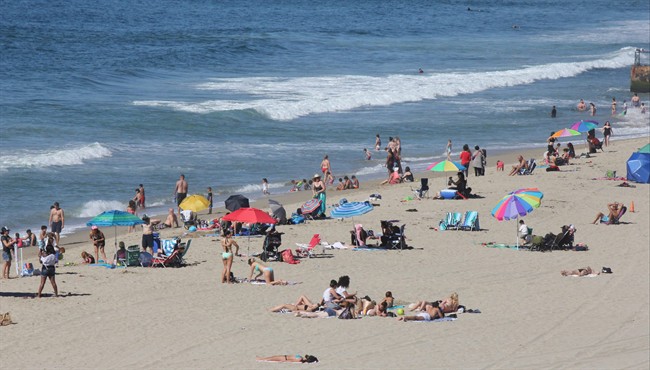The first long weekend of the summer has arrived – you may be off to the cottage, the beach or even staycationing in your backyard for some barbecue. Wherever you’re soaking up the sun, make sure you’re looking after your skin.

Sun safety is often overlooked during the busy summer months. It’s also hard to figure out when you should apply and reapply sunblock and what type to shop for.
A new Consumer Reports investigation found, for example, that some sprays, sticks and lotions with an SPF of 30 or higher don’t actually meet the claims made on their labels.
Here’s what you need to know about sun safety for the summer and how to protect your skin:
What should Canadians look for in a sunscreen?
The Canadian Dermatology Association recommends a sunblock with an SPF 30 or higher. It should also come with broad spectrum protection – this protects you from UVA and UVB rays.
There are three spectrums of light – ultraviolet A (long rays) is tied to aging the skin, ultraviolet B (short rays) can lead to burns and ultraviolet C isn’t as worrisome because most of the rays are absorbed by the ozone layer, according to Dr. Kucy Pon, a dermatologist at Sunnybrook Hospital.
READ MORE: 5 tips for a healthy summer long weekend
UVA and UVB can contribute to skin cancer and damaging your skin, she warns.
“Both are carcinogenic in different ways so it’s important for sunscreen to block both,” Dr. Anatoli Freiman, a dermatologist and medical director of the Toronto Dermatology Centre, explained.
An SPF 30 would cover off about 97 per cent of UVB rays, but wearing a higher SPF may be your best bet because it’ll be more effective. It’s easy for consumers to miss spots or apply too little to certain parts of their body so the higher protection would compensate, Freiman said.
If you’ve had skin cancer or a strong family history of the disease, stick to a higher SPF.
Here’s a list of ratings from Consumer Reports on sunblocks and if they met their claims.
How should you apply sunscreen for best protection?
Sunblock should be applied 15 minutes before going outside. If you happen to forget and head out, apply it as soon as possible anyway – Freiman says it should start working immediately.
“It should be reapplied every two hours when you’re exposed to sunrays. If you’re sweating, swimming, or exposed to water, you may need to top up more often,” Freiman advises.
READ MORE: How extreme heat affects the body
As a general rule of thumb, if you’re applying sunscreen from head to toe, use a shot glass-sized amount – or two tablespoons. Use half of a teaspoon for each part of your body – half of a teaspoon for your face, another half for your left leg, for example.
Sunscreens can be applied as lotions and even aerosol sprays. The sprays are seen as more finicky because you can’t tell if you’re applying it evenly but the experts say your decision-making in this case is up to personal preference.
If you want a chemical-free sunblock, Freiman says options with zinc oxide are readily available, too.
If you spend a lot of time in the water, opt for a water-resistant sunblock.
What are some common mistakes Canadians make?
For starters, they may be going out when the sun’s UV index is at its highest in the afternoon.
“You’ll burn much faster than first thing in the morning or later on in the day when the sun isn’t at its peak,” Pon said.
READ MORE: 9 tips for healthy summertime barbecuing
People often forget to apply sunblock to certain parts of their body, too: the earlobes, backs of their hands, behind their knees, toes, nose and scalp (if you have a shaved head, for example).
Some Canadians may think the sun may not be as strong as it is in the Caribbean. That’s not the case.
READ MORE: Is aerosol sunscreen safe for you? Inhaling chemicals is a concern
“You’re going to get sunburns everywhere,” Freiman says. Both doctors see patients over the course of the summer months with severe burns to their skin.
If you’re spending extended time outdoors, look for cover under a tree, umbrella or shade from a building.
Keep in mind, you’re also getting sun exposure while in your car, too. New research suggests that your vehicle’s side windows don’t offer as much protection as the windshield.
What should Canadians do if they’re suffering from sunburn?
If you’re dealing with redness and pain from a burning sensation, you’re dealing with sunburn.
“The skin is trying to protect itself from the sun by tanning. Whenever you tan, there’s a little injury to your skin. Some people don’t tan well and so they burn and it’s damage from the sun,” Pon explained.
READ MORE: What parents need to know about secondary drowning
Eighty per cent of premature skin aging is related to the sun. If you want to minimize wrinkles, sun spots and aging skin, look after your skin.
The effects of sunburn can add up long-term, too.
“Chronic accumulated sun damage can lead to developing skin cancer, but some people are genetically predisposed,” Pon says.
People with medical conditions, such as lupus, or who rely on medications for high blood pressure, could face an increased risk of sunburn, too.
READ MORE: Why some Canadians are more prone to mosquito bites than others
If you’ve burnt, get out of the sun, reapply sunscreen and use a cooling compress to ease the pain. Aloe and Aspirin are also used as tools to help with pain management.
If the sunburn is severe, head to the doctor’s office for a prescription cream and keep your skin moisturized, the experts say.
carmen.chai@globalnews.ca
Follow @Carmen_Chai




Comments